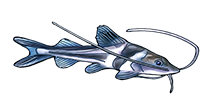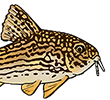/siluriformes/loricariidae/baryancistrus/xanthellus/1.jpg) L018
L018/siluriformes/loricariidae/baryancistrus/xanthellus/2.jpg)
/siluriformes/loricariidae/baryancistrus/xanthellus/3.jpg)
/siluriformes/loricariidae/baryancistrus/xanthellus/4.jpg) Juvenile with Rio Rio Xingu in background
Juvenile with Rio Rio Xingu in background/siluriformes/loricariidae/baryancistrus/xanthellus/5.jpg)
/siluriformes/loricariidae/baryancistrus/xanthellus/6.jpg) L177
L177/siluriformes/loricariidae/baryancistrus/xanthellus/7.jpg) Ventral view (female)
Ventral view (female)/siluriformes/loricariidae/baryancistrus/xanthellus/8.jpg) Close-up of mouth
Close-up of mouth/siluriformes/loricariidae/baryancistrus/xanthellus/9.jpg) Dorsal view
Dorsal view/siluriformes/loricariidae/baryancistrus/xanthellus/10.jpg) L177
L177/siluriformes/loricariidae/baryancistrus/xanthellus/11.jpg) L177
L177/siluriformes/loricariidae/baryancistrus/xanthellus/12.jpg) L018 above, L177 below
L018 above, L177 below/siluriformes/loricariidae/baryancistrus/xanthellus/13.jpg) Lateral view
Lateral view/siluriformes/loricariidae/baryancistrus/xanthellus/14.jpg)
/siluriformes/loricariidae/baryancistrus/xanthellus/15.jpg) L177
L177/siluriformes/loricariidae/baryancistrus/xanthellus/16.jpg) Underwater in Rio Xingu habitat
Underwater in Rio Xingu habitat/siluriformes/loricariidae/baryancistrus/xanthellus/17.jpg)
/siluriformes/loricariidae/baryancistrus/xanthellus/18.jpg)
/siluriformes/loricariidae/baryancistrus/xanthellus/19.jpg) Female
Female/siluriformes/loricariidae/baryancistrus/xanthellus/20.jpg) Cachoeira Cutuvelo on the Rio Xingu
Cachoeira Cutuvelo on the Rio Xingu/siluriformes/loricariidae/baryancistrus/xanthellus/21.jpg) Habitat: Shallow, fast-flowing Rio Xingu
Habitat: Shallow, fast-flowing Rio Xingu/siluriformes/loricariidae/baryancistrus/xanthellus/22.jpg) Habitat: Underwater
Habitat: Underwater/siluriformes/loricariidae/baryancistrus/xanthellus/23.jpg) Habitat: above water
Habitat: above water/siluriformes/loricariidae/baryancistrus/xanthellus/24.jpg) On their way to market
On their way to market/siluriformes/loricariidae/baryancistrus/xanthellus/25.jpg) L085 adult male
L085 adult male/siluriformes/loricariidae/baryancistrus/xanthellus/26.jpg) L085 adult female
L085 adult female/siluriformes/loricariidae/baryancistrus/xanthellus/27.jpg) Adults prepared for eating
Adults prepared for eating/siluriformes/loricariidae/baryancistrus/xanthellus/28.jpg) Female carrying eggs
Female carrying eggs/siluriformes/loricariidae/baryancistrus/xanthellus/29.jpg) Stomach and intestine
Stomach and intestine/siluriformes/loricariidae/baryancistrus/xanthellus/30.jpg) LDA060
LDA060/siluriformes/loricariidae/baryancistrus/xanthellus/31.jpg) Feeding on red pepper (left)
Feeding on red pepper (left)/siluriformes/loricariidae/baryancistrus/xanthellus/32.jpg) L177
L177/siluriformes/loricariidae/baryancistrus/xanthellus/33.jpg) L177
L177/siluriformes/loricariidae/baryancistrus/xanthellus/34.jpg) L177 sub adult
L177 sub adult/siluriformes/loricariidae/baryancistrus/xanthellus/35.jpg)
/siluriformes/loricariidae/baryancistrus/xanthellus/36.jpg)
/siluriformes/loricariidae/baryancistrus/xanthellus/37.jpg) L177
L177/siluriformes/loricariidae/baryancistrus/xanthellus/38.jpg) L081
L081/siluriformes/loricariidae/baryancistrus/xanthellus/39.jpg) LDA116
LDA116/siluriformes/loricariidae/baryancistrus/xanthellus/40.jpg) L081 yellow variation, captured below Altamira
L081 yellow variation, captured below Altamira/siluriformes/loricariidae/baryancistrus/xanthellus/41.jpg) L081
L081/siluriformes/loricariidae/baryancistrus/xanthellus/42.jpg) L081
L081/siluriformes/loricariidae/baryancistrus/xanthellus/43.jpg) L081 close-up of mouth
L081 close-up of mouth/siluriformes/loricariidae/baryancistrus/xanthellus/44.jpg) L081
L081/siluriformes/loricariidae/baryancistrus/xanthellus/45.jpg) L081
L081/siluriformes/loricariidae/baryancistrus/xanthellus/46.jpg) L081
L081/siluriformes/loricariidae/baryancistrus/xanthellus/47.jpg) L081
L081/siluriformes/loricariidae/baryancistrus/xanthellus/48.jpg) L081 close-up of female head
L081 close-up of female head/siluriformes/loricariidae/baryancistrus/xanthellus/49.jpg) L081 close-up of male head
L081 close-up of male head/siluriformes/loricariidae/baryancistrus/xanthellus/50.jpg)
/siluriformes/loricariidae/baryancistrus/xanthellus/51.jpg) L081 ventral view
L081 ventral view/siluriformes/loricariidae/baryancistrus/xanthellus/52.jpg)
/siluriformes/loricariidae/baryancistrus/xanthellus/53.jpg) L085 Cachoeira Grande do Iriri, 03??50
L085 Cachoeira Grande do Iriri, 03??50
| Scientific Name | Baryancistrus xanthellus Rapp Py-Daniel, Zuanon & de Oliveira, 2011 |
| Common Names | L018, Gold Nugget Pleco L081, L085, L177, LDA060, LDA116, LDA117, Guldklump-sugemalle (Denmark) |
| Type Locality | Rio Xingú, in the vicinity of the cachoeira Buraco do Inferno, 3°27'07"S, 51°41'53"W, Senador José Porfirio, Pará, Brazil. |
| Pronunciation | bah ree ann siss truss |
| Etymology | Greek, barys = heavy + Greek, agkistron = hook - Essentially "Heavy Ancistrus". From the Greek xanthellus, yellow, in allusion to the bright color of the specimens. |
| Articles | |
| Size | 240mm or 9.4" SL. Find near, nearer or same sized spp. |
| Identification | The combination of yellow markings on the dorsal and caudal fin and numerous yellow spots on the body is specific to this species. L081 (not mentioned in the description of B. xanthellus) is a fine spotted colour form with a dark base colour. L177 is a variety with larger spots more obvious in younger specimens and LDA060 is a variety with ill-formed spots or flakes. All are main channel fishes. After the description of the species in 2011, Aqualog added LDA116 and LDA117 both from the river around Sao Felix do Xingu. LDA116 is a paler colour form with faded almost invisible fine spots. Juveniles show a thin dorsal yellow seam and a little more yellow at the edge of the caudal which it keeps into adulthood. LDA117, by contrast, has a lot of yellow in these fins - about one-third yellow in the dorsal and the caudal fin is about half yellow. The spots are medium-sized and dense. However, adults lose all bright yellow spots and seams with the spots fading to small indistinct marks. |
| Sexing | Dimorphism is difficult to notice unless the fish are at full breeding size. Males have a flatter, more levelled slope to their foreheads and are slightly wider about the head. Females have a more rounded forehead and are slightly plumper at the mid body when in spawning condition. There is no noticeable difference in odontodal growth in either gender. |
| General Remarks | The common name came from residents of Altamira and the surrounding area who used to work in gold mining in the river (and hence were used to precarious diving for work). When mining there died out in the 1980s, they found a new source of income from collecting "Acari-Gold" - the Xingu's omnipresent Gold Nugget Pleco. |
| Distribution | This species is widespread and common in the Rio Xingu. Exports are collected near Altamira, from the area called Volta Grande do rio Xingu, an area immediately above Belo Monte falls, and from rio Iriri, the larger tributary of rio Xingu. L177 is from further upstream near the where the Rio Iriri joins the Xingu. L081 is reported in DATZ to represent three very similar small spotted gold nugget plecos. It was said to be hard to keep alive for any length of time; the others are considerably more hardy - however as more is known this appears more to be a result of transit times. These fish all represent the range of population, as more and more areas are collected, there seems to be a little pattern to the matching of colour form to geographic location. Amazon, Lower Amazon, Xingu, Lower Xingu (click on these areas to find other species found there) Amazon, Lower Amazon, Xingu, Iriri (click on these areas to find other species found there) Login to view the map. |
| IUCN Red List Category | Near Threatened , range map and more is available on the IUCN species page. Last assessed 2018. |
| pH | 6.4 - 7.6 |
| Temperature | 25.0-30.0°C or 77-86°F (Show species within this range) |
| Other Parameters | Clear with a noticeable current. |
| Feeding | These fish are grazers, but not in the sense that they eat only vegetation. They actually sift and chew at the film of organic matter on hard surfaces in search of higher protein foods. In the wild this would constitute mainly of algae and vegetable matter, but with a variety of foods from small insect larvae and crustaceans to other animals eggs. With this in mind, a largely vegetarian diet, cucumber and courgette appear on the accepted menu, with treats of frozen foods such as bloodworm and blackworm, along with frozen prawns. Algae and plants are avoided. Accepted food morsel size changes with age in all of these fish. Best results are obtained by offer these foods in a paste. The very long intestine of these fishes indicates a biology adapted to breaking down food high in vegetable content. User data. |
| Furniture | Bogwood and rock caves. Plants are up to you but won't be molested by the fish. |
| Compatibility | Gold nuggets are territorial to other bottom dwellers and downright vicious to other gold nuggets. This stems from a desire to find and defend the best spawning cave, so take this into account if you plan to introduce these fish into a catfish tank. They do well in a community environment that fits their other requirements. Be careful with adult fish, they can kill each other in a crowded space. |
| Suggested Tankmates | Although strong currents are needed for breeding attempts, only good water quality and a high temperature are required for this fishes successful onward maintenance. Thus, characins are good biotope fish but you could look further afield at discus and gouramis. Most other cichlids tend to over compete for food with these fish, so be careful especially when introducing new gold nuggets. |
| Breeding | Well documented breeding in captivity has been accomplished twice. The fishes had a very specialised diet of blended meat, fish and vegetables and were kept in a large aquarium with lots of current, high DO and spawned at 30°C. The free-swimming fry were fed the same food to raise them. |
| Breeding Reports | There are 2 breeding reports, read them all here. |
| Reference | Neotropical Ichthyology v. 9 (no. 2), pp 242, Figs. 1-2. |
| Registered Keepers | There are 600 registered keepers, view all "my cats" data. |
| Wishlists | Love this species? Click the heart to add it to your wish list. There are 32 wishes to keep this species, see who wants what. |
| Spotters | Spotted this species somewhere? Click the binoculars! There are 100 records of this fish being seen, view them all. |
| Forum BBCode | |
| Search for B. xanthellus | |
| Look up B. xanthellus on AquaticRepublic.com | |
 | Look up B. xanthellus on Fishbase |
 | Look up B. xanthellus on Encyclopedia of Life |
 | Look up B. xanthellus on Global Biodiversity Information Facility |
| LFS label creator ARN ref:1.4.19.153 | |
| Last Update | 2025 Jan 01 12:03 (species record created: 2001 Apr 19 00:00) |




